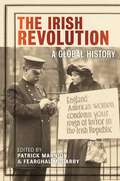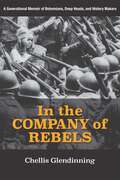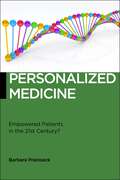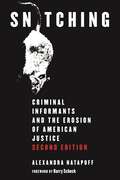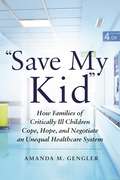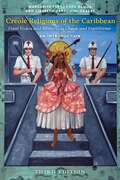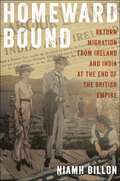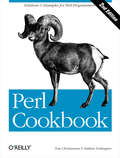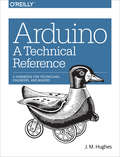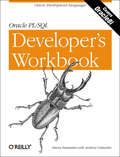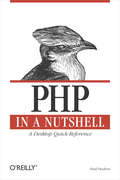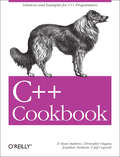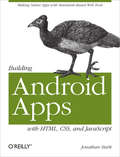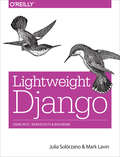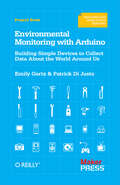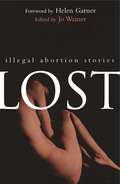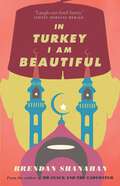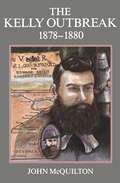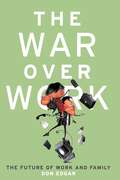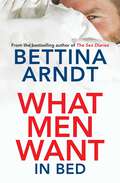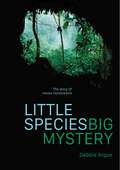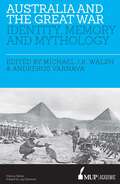- Table View
- List View
The Irish Revolution: A Global History (The Glucksman Irish Diaspora Series #3)
by Patrick Mannion Fearghal McGarryHow the Irish Revolution was shaped by international actors and events The Irish War of Independence is often understood as the culmination of centuries of political unrest between Ireland and the English. However, the conflict also has a vitally important yet vastly understudied international dimension. The Irish Revolution: A Global History reassesses the conflict as an inherently transnational event, examining how circumstances and individuals abroad shaped the course Ireland’s struggle for independence.Bringing together leading international scholars of modern Ireland, its diaspora, and the British Empire, this volume discusses the Irish revolution in a truly global sense. The text situates the conflict in the wider context of the international flourishing of anti-colonial movements following World War I. Despite the differences between these movements, their proponents communicated extensively with each other, learning from and engaging with other revolutionaries in anti-imperial metropoles such as Paris, London, and New York. The contributors to this volume argue that Irish nationalists at home and abroad were intimately involved in this exchange, from mobilizing Ireland’s vast diaspora in support of Irish independence to engaging directly with radical causes elsewhere. The Irish Revolution is a vital work for all those interested in Irish history, providing a new understanding of Ireland’s place in the evolving postwar world.
In the Company of Rebels: A Generational Memoir of Bohemians, Deep Heads, and History Makers
by Chellis GlendinningMeetings with remarkable activists since the 1960s American social change movements dominated the 1960s and 1970s, an era brought about and influenced not by a handful of celebrity activists but by people who cared. These history makers together transformed the political and spiritual landscape of America and laid the foundation for many of the social movements that exist today. Through a series of 43 vignettes—tight biographical sketches of the characters and intimate memories of her personal encounters with them—the author creates a collective portrait of the rebels, artists, radicals, and thinkers who through word and action raised many of the issues of justice, the environment, feminism, and colonialism that we are now familiar with. From Berkeley to Bolivia, from New York to New Mexico, a complex, multi-layered radical history unfolds through the stories and lives of the characters. From Marty Schiffenhauer, who fought through the first rent-control law in the United States, to Ponderosa Pine, who started the All-Species Parade and never wore shoes, to Dan and Patricia Ellsberg, who released the Pentagon Papers and became life-long anti-war and antinuclear activists, the portraits bring out some of the vibrant, irreverent energy, the unswerving commitment, and the passion for life of these generations of activists. In our present moment, as many people find themselves in the streets protesting for the first time in their lives, In the Company of Rebels makes the connection to this relatively recent rebellious era.As the author comments on her own twenty-year old self, sitting at the counter of Cody’s Books in Berkeley in the early 1970s, thrilled about the times but oblivious of the work that came before: “I didn’t know anything about this courageous and colorful past. But now I know.”
Personalized Medicine: Empowered Patients in the 21st Century? (Biopolitics #7)
by Barbara PrainsackInside today's data-driven personalized medicine, and the time, effort, and information required from patients to make it a realityMedicine has been personal long before the concept of “personalized medicine” became popular. Health professionals have always taken into consideration the individual characteristics of their patients when diagnosing, and treating them. Patients have cared for themselves and for each other, contributed to medical research, and advocated for new treatments. Given this history, why has the notion of personalized medicine gained so much traction at the beginning of the new millennium? Personalized Medicine investigates the recent movement for patients’ involvement in how they are treated, diagnosed, and medicated; a movement that accompanies the increasingly popular idea that people should be proactive, well-informed participants in their own healthcare.While it is often the case that participatory practices in medicine are celebrated as instances of patient empowerment or, alternatively, are dismissed as cases of patient exploitation, Barbara Prainsack challenges these views to illustrate how personalized medicine can give rise to a technology-focused individualism, yet also present new opportunities to strengthen solidarity. Facing the future, this book reveals how medicine informed by digital, quantified, and computable information is already changing the personalization movement, providing a contemporary twist on how medical symptoms or ailments are shared and discussed in society. Bringing together empirical work and critical scholarship from medicine, public health, data governance, bioethics, and digital sociology, Personalized Medicine analyzes the challenges of personalization driven by patient work and data. This compelling volume proposes an understanding that uses novel technological practices to foreground the needs and interests of patients, instead of being ruled by them.
Snitching: Criminal Informants and the Erosion of American Justice, Second Edition
by Alexandra NatapoffReveals the secretive, inaccurate, and often violent ways that the American criminal system really worksCurtis Flowers spent twenty-three years on death row for a murder he did not commit. Atlanta police killed 92-year-old Kathryn Johnston during a misguided raid on her home. Rachel Hoffman was murdered at age twenty-three while working for Florida police. Such tragedies are consequences of snitching. Although it is nearly invisible to the public, the massive informant market shapes the American legal system in risky and sometimes shocking ways. Police rely on criminal suspects to obtain warrants, to perform surveillance, and to justify arrests. Prosecutors negotiate with defendants for information and cooperation, offering to drop charges or lighten sentences in exchange. In this book, Alexandra Natapoff provides a comprehensive analysis of this powerful and problematic practice. She shows how informant deals generate unreliable evidence, allow serious criminals to escape punishment, endanger the innocent, and exacerbate distrust between police and poor communities of color. First published over ten years ago, Snitching has become known as the “informant bible,” a leading text for advocates, attorneys, journalists, and scholars. This influential book has helped free the innocent, it has fueled reform at the state and federal level, and it is frequently featured in high-profile media coverage of snitching debacles. This updated edition contains a decade worth of new stories, new data, new legislation and legal developments, much of it generated by the book itself and by Natapoff’s own work. In clear, accessible language, the book exposes the social destruction that snitching can cause in heavily-policed Black neighborhoods, and how using criminal informants renders our entire penal process more secretive and less fair. By delving into the secretive world of criminal informants, Snitching reveals deep and often disturbing truths about the way American justice really works.
"Save My Kid": How Families of Critically Ill Children Cope, Hope, and Negotiate an Unequal Healthcare System
by Amanda M. GenglerA frank analysis of the medical and emotional inequalities that pervade the healthcare process for critically ill children Families who have a child with a life-threatening illness face a daunting road ahead of them, one that not only upends their everyday lives, but also strikes at the very heart of parenthood. In “Save My Kid,” Amanda M. Gengler traces the emotional difficulties these families navigate as they confront a fundamentally unequal healthcare system in the United States. Gengler reveals the unrecognized, everyday inequalities tangled up in the process of seeking medical care, showing how different families manage their children’s critical illnesses. She also uncovers the role that emotional goals—deeply rooted in the culture of illness and medicine—play in medical decision-making, healthcare interactions, and the end of children’s lives. A deeply compassionate read, “Save My Kid” is an inside look at inequality in healthcare among those with the most at stake.
Creole Religions of the Caribbean, Third Edition: An Introduction (Religion, Race, and Ethnicity)
by Lizabeth Paravisini-Gebert Margarite Fernández OlmosAn updated introduction to the religions developed in the Caribbean regionCreole Religions of the Caribbean offers a comprehensive introduction to the overlapping religions that have developed as a result of the creolization process. Caribbean peoples drew on the variants of Christianity brought by European colonizers, as well as on African religious and healing traditions and the remnants of Amerindian practices, to fashion new systems of belief. From Vodou, Santería, Regla de Palo, the Abakuá Secret Society, and Obeah to Quimbois and Espiritismo, the volume traces the historical–cultural origins of the major Creole religions, as well as the newer traditions such as Rastafari.This third edition updates the scholarship by featuring new critical approaches that have been brought to bear on the study of religion, such as queer studies, environmental studies, and diasporic studies. The third edition also expands the regional considerations of the diaspora to the US Latinx communities that are influenced by Creole spiritual practices, taking into account the increased significance of material culture?art, music, literature, and healing practices influenced by Creole religions.
Homeward Bound: Return Migration from Ireland and India at the End of the British Empire (The Glucksman Irish Diaspora Series)
by Niamh DillonFirsthand accounts of migrants who settled in Britain offer new insights into empire, belonging, migration, and diasporaHomeward Bound shines a light on a neglected aspect of twentieth-century migration history. It compares two groups of migrants—Southern Irish Protestants and the British in India—who “returned” to Britain from Ireland and India after independence in 1922 and 1947. By looking across national boundaries, Niamh Dillon explores both individual and collective narratives of imperial identity in the late British Empire and the prompts for return. For both groups, the success of national independence movements in the first half of the twentieth century was cataclysmic and prompted a large-scale migration to Britain. Between 1911 and 1926, the number of Protestants in the Irish Free State dropped from approximately 313,000 to 208,000, and much of the British population left India. Although these numbers are significant, these two groups have largely been ignored by historians and have not been compared before. Though instability in the new political order and lack of livelihood were determining factors in the decision to migrate, Dillon argues that Southern Irish Protestants and the British community in India “returned” to Britain after independence principally because these former elites no longer had a clearly defined role in the new post-colonial era. Return migrants chose Britain because of continuing connections with it as “home,” but often found their colonial experience was not valued in a country re-orienting itself to the post-war order. Through interviews with those who experienced these events first-hand and the recently opened files of the Irish Grants Committee at the National Archives in Britain, this book offers new insights into the history of migration and the affinity these migrants felt with Britain and with the empire.
Programming Excel with VBA and .NET: Solve Real-World Problems with Excel
by Jeff Webb Steve SaundersWhy program Excel? For solving complex calculations and presenting results, Excel is amazingly complete with every imaginable feature already in place. But programming Excel isn't about adding new features as much as it's about combining existing features to solve particular problems. With a few modifications, you can transform Excel into a task-specific piece of software that will quickly and precisely serve your needs. In other words, Excel is an ideal platform for probably millions of small spreadsheet-based software solutions. The best part is, you can program Excel with no additional tools. A variant of the Visual Basic programming language, VB for Applications (VBA) is built into Excel to facilitate its use as a platform. With VBA, you can create macros and templates, manipulate user interface features such as menus and toolbars, and work with custom user forms or dialog boxes. VBA is relatively easy to use, but if you've never programmed before, Programming Excel with VBA and .NET is a great way to learn a lot very quickly. If you're an experienced Excel user or a Visual Basic programmer, you'll pick up a lot of valuable new tricks. Developers looking forward to .NET development will also find discussion of how the Excel object model works with .NET tools, including Visual Studio Tools for Office (VSTO). This book teaches you how to use Excel VBA by explaining concepts clearly and concisely in plain English, and provides plenty of downloadable samples so you can learn by doing. You'll be exposed to a wide range of tasks most commonly performed with Excel, arranged into chapters according to subject, with those subjects corresponding to one or more Excel objects. With both the samples and important reference information for each object included right in the chapters, instead of tucked away in separate sections, Programming Excel with VBA and .NET covers the entire Excel object library. For those just starting out, it also lays down the basic rules common to all programming languages. With this single-source reference and how-to guide, you'll learn to use the complete range of Excel programming tasks to solve problems, no matter what you're experience level.
Perl Cookbook: Solutions & Examples for Perl Programmers
by Tom Christiansen Nathan TorkingtonFind a Perl programmer, and you'll find a copy of Perl Cookbook nearby. Perl Cookbook is a comprehensive collection of problems, solutions, and practical examples for anyone programming in Perl. The book contains hundreds of rigorously reviewed Perl "recipes" and thousands of examples ranging from brief one-liners to complete applications.The second edition of Perl Cookbook has been fully updated for Perl 5.8, with extensive changes for Unicode support, I/O layers, mod_perl, and new technologies that have emerged since the previous edition of the book. Recipes have been updated to include the latest modules. New recipes have been added to every chapter of the book, and some chapters have almost doubled in size.Covered topic areas include:Manipulating strings, numbers, dates, arrays, and hashesPattern matching and text substitutionsReferences, data structures, objects, and classesSignals and exceptionsScreen addressing, menus, and graphical applicationsManaging other processesWriting secure scriptsClient-server programmingInternet applications programming with mail, news, ftp, and telnetCGI and mod_perl programmingWeb programmingSince its first release in 1998, Perl Cookbook has earned its place in the libraries of serious Perl users of all levels of expertise by providing practical answers, code examples, and mini-tutorials addressing the challenges that programmers face. Now the second edition of this bestselling book is ready to earn its place among the ranks of favorite Perl books as well.Whether you're a novice or veteran Perl programmer, you'll find Perl Cookbook, 2nd Edition to be one of the most useful books on Perl available. Its comfortable discussion style and accurate attention to detail cover just about any topic you'd want to know about. You can get by without having this book in your library, but once you've tried a few of the recipes, you won't want to.
Arduino: A Handbook for Technicians, Engineers, and Makers
by J. M. HughesRather than yet another project-based workbook, Arduino: A Technical Reference is a reference and handbook that thoroughly describes the electrical and performance aspects of an Arduino board and its software.This book brings together in one place all the information you need to get something done with Arduino. It will save you from endless web searches and digging through translations of datasheets or notes in project-based texts to find the information that corresponds to your own particular setup and question.Reference features include pinout diagrams, a discussion of the AVR microcontrollers used with Arduino boards, a look under the hood at the firmware and run-time libraries that make the Arduino unique, and extensive coverage of the various shields and add-on sensors that can be used with an Arduino. One chapter is devoted to creating a new shield from scratch.The book wraps up with detailed descriptions of three different projects: a programmable signal generator, a "smart" thermostat, and a programmable launch sequencer for model rockets. Each project highlights one or more topics that can be applied to other applications.
Oracle PL/SQL Programming: Oracle Development Languages
by Steven Feuerstein Andrew OdewahnHowever excellent they are, most computer books are inherently passive--readers simply take in text without having any opportunity to react to it. The Oracle PL/SQL Developer's Workbook is a different kind of animal! It's designed to engage you actively, to get you solving programming problems immediately, and to help you apply what you've learned about PL/SQL--and in the process deepen your knowledge of the language. By tackling the exercises in this workbook, you'll find yourself moving more rapidly along the learning curve to join the growing ranks of PL/SQL experts.The Oracle PL/SQL Developer's Workbook is a companion to Steven Feuerstein's bestselling Oracle PL/SQL Programming and his other PL/SQL books from O'Reilly. It contains a carefully constructed set of problems and solutions that will test your language skills and help you become a better developer--both with PL/SQL and with other languages. Exercises are provided at three levels: beginner, intermediate, and expert. The workbook exercises cover all the major features of PL/SQL, including those new to Oracle8i (e.g., Java and web features, autonomous transactions, and bulk binds).You'll find chapters on:Basic language elements--variables, naming, loops, conditional and sequential control, exception handling, and records.Data structures--index-by tables, nested tables, variables arrays (VARRAYs), and object technology.Database interaction--cursors, DML and transaction management, cursor variables, and native dynamic SQLProgram construction--procedures, functions, blocks, packages, database triggers, and calling PL/SQL functions in SQL.Built-in functionality--the character, date, conversion, numeric, and miscellaneous functions, and the DBMS_SQL, DBMS_PIPE, DBMS_OUTPUT, UTL_FILE, and DBMS_JOB built-in packages.Miscellaneous topics--using Java with PL/SQL, external programs, PL/SQL web development, tuning PL/SQL, and PL/SQL for DBAs.
PHP in a Nutshell: A Desktop Quick Reference
by Paul HudsonNow installed on more than 20 million Internet domains around the world, PHP is an undisputed leader in web programming languages. Database connectivity, powerful extensions, and rich object-orientation are all reasons for its popularity, but nearly everyone would agree that, above all, PHP is one of the easiest languages to learn and use for developing dynamic web applications. The ease of development and simplicity of PHP, combined with a large community and expansive repository of open source PHP libraries, make it a favorite of web designers and developers worldwide.PHP in a Nutshell is a complete reference to the core of the language as well as the most popular PHP extensions. This book doesn't try to compete with or replace the widely available online documentation. Instead, it is designed to provide depth and breadth that can't be found elsewhere. PHP in a Nutshell provides the maximum information density on PHP, without all the fluff and extras that get in the way. The topic grouping, tips, and examples in this book complement the online guide and make this an essential reference for every PHP programmer. This book focuses on the functions commonly used by a majority of developers, so you can look up the information you need quickly. Topics include:Object-oriented PHPNetworkingString manipulationWorking with filesDatabase interactionXMLMultimedia creationMathematicsWhether you're just getting started or have years of experience in PHP development, PHP in a Nutshell is a valuable addition to your desk library.
C++ Cookbook: Solutions and Examples for C++ Programmers
by Jeff Cogswell Christopher Diggins Jonathan Turkanis D. Ryan StephensDespite its highly adaptable and flexible nature, C++ is also one of the more complex programming languages to learn. Once mastered, however, it can help you organize and process information with amazing efficiency and quickness.The C++ Cookbook will make your path to mastery much shorter. This practical, problem-solving guide is ideal if you're an engineer, programmer, or researcher writing an application for one of the legions of platforms on which C++ runs. The algorithms provided in C++ Cookbook will jump-start your development by giving you some basic building blocks that you don't have to develop on your own. Less a tutorial than a problem-solver, the book addresses many of the most common problems you're likely encounter--whether you've been programming in C++ for years or you're relatively new to the language. Here are just some of the time-consuming tasks this book contains practical solutions for:Reading the contents of a directoryCreating a singleton classDate and time parsing/arithmeticString and text manipulationWorking with filesParsing XMLUsing the standard containers Typical of O'Reilly's "Cookbook" series, C++ Cookbook is written in a straightforward format, featuring recipes that contain problem statements and code solutions, and apply not to hypothetical situations, but those that you're likely to encounter. A detailed explanation then follows each recipe in order to show you how and why the solution works. This question-solution-discussion format is a proven teaching method, as any fan of the "Cookbook" series can attest to. This book will move quickly to the top of your list of essential C++ references.
Building Android Apps with HTML, CSS, and JavaScript: Making Native Apps With Standards-based Web Tools (Oreilly And Associate Ser.)
by Paco Hope Jonathan Stark Paco Nathan John Papaconstantinou Paco LagerstromIf you know HTML, CSS, and JavaScript, you already have the tools you need to develop Android applications. This hands-on book shows you how to use these open source web standards to design and build apps that can be adapted for any Android device -- without having to use Java.You'll learn how to create an Android-friendly web app on the platform of your choice, and then convert it to a native Android app with the free PhoneGap framework. Discover why device-agnostic mobile apps are the wave of the future, and start building apps that offer greater flexibility and a broader reach.Learn the basics for making a web page look great on the Android web browserConvert a website into a web application, complete with progress indicators and moreAdd animation with jQTouch to make your web app look and feel like a native Android appTake advantage of client-side data storage with apps that run even when the Android device is offlineUse PhoneGap to hook into advanced Android features -- including the accelerometer, geolocation, and alertsTest and debug your app on the Web under load with real users, and then submit the finished product to the Android MarketThis book received valuable community input through O'Reilly's Open Feedback Publishing System (OFPS). Learn more at http://labs.oreilly.com/ofps.html.
Lightweight Django: Using REST, WebSockets, and Backbone
by Mark Lavin Julia SolórzanoHow can you take advantage of the Django framework to integrate complex client-side interactions and real-time features into your web applications? Through a series of rapid application development projects, this hands-on book shows experienced Django developers how to include REST APIs, WebSockets, and client-side MVC frameworks such as Backbone.js into new or existing projects.Learn how to make the most of Django’s decoupled design by choosing the components you need to build the lightweight applications you want. Once you finish this book, you’ll know how to build single-page applications that respond to interactions in real time. If you’re familiar with Python and JavaScript, you’re good to go.Learn a lightweight approach for starting a new Django projectBreak reusable applications into smaller services that communicate with one anotherCreate a static, rapid prototyping site as a scaffold for websites and applicationsBuild a REST API with django-rest-frameworkLearn how to use Django with the Backbone.js MVC frameworkCreate a single-page web application on top of your REST APIIntegrate real-time features with WebSockets and the Tornado networking libraryUse the book’s code-driven examples in your own projects
Real-Time Communication with WebRTC: Peer-to-Peer in the Browser
by Salvatore Loreto Simon Pietro RomanoDeliver rich audio and video real-time communication and peer-to-peer data exchange right in the browser, without the need for proprietary plug-ins. This concise hands-on guide shows you how to use the emerging Web Real-Time Communication (WebRTC) technology to build a browser-to-browser application, piece by piece.The authors’ learn-by-example approach is perfect for web programmers looking to understand real-time communication, and telecommunications architects unfamiliar with HTML5 and JavaScript-based client-server web programming. You’ll use a ten-step recipe to create a complete WebRTC system, with exercises that you can apply to your own projects.Tour the WebRTC development cycle and trapezoid architectural modelUnderstand how and why VoIP is shifting from standalone functionality to a browser componentUse mechanisms that let client-side web apps interact with browsers through the WebRTC APITransfer streaming data between browser peers with the RTCPeerConnection APICreate a signaling channel between peers for setting up a WebRTC sessionPut everything together to create a basic WebRTC system from scratchLearn about conferencing, authorization, and other advanced WebRTC features
Environmental Monitoring with Arduino: Building Simple Devices to Collect Data About the World Around Us
by Emily Gertz Patrick Di JustoAfter the devastating tsunami in 2011, DYIers in Japan built their own devices to detect radiation levels, then posted their finding on the Internet. Right now, thousands of people worldwide are tracking environmental conditions with monitoring devices they’ve built themselves. You can do it too!This inspiring guide shows you how to use Arduino to create gadgets for measuring noise, weather, electromagnetic interference (EMI), water purity, and more. You’ll also learn how to collect and share your own data, and you can experiment by creating your own variations of the gadgets covered in the book. If you’re new to DIY electronics, the first chapter offers a primer on electronic circuits and Arduino programming.Use a special microphone and amplifier to build a reliable noise monitorCreate a gadget to detect energy vampires: devices that use electricity when they’re “off”Examine water purity with a water conductivity deviceMeasure weather basics such as temperature, humidity, and dew pointBuild your own Geiger counter to gauge background radiationExtend Arduino with an Ethernet shield—and put your data on the InternetShare your weather and radiation data online through Pachube
Lost: Illegal Abortion Stories
by Jo Wainer'It is chastening to read these bald tales, shockingly direct and unvarnished. Each story contains matter enough for a novel. Each one is a window onto a larger life, a broader world: a tantalising view of endlessly unfolding complexities.'-Helen Garner Twenty years ago, Dr Bertram Wainer, the abortion reform doctor and campaigner, placed an advertisement in a newspaper asking women who had illegal abortions to come forward to tell their stories. Their personal testimonies and the accounts from doctors and nurses are published for the first time in this collection. Women had to draw on deep reservoirs of courage and determination faced with the fear of illegal abortion. This collection tells of some of those acts of courage and the difficulties society placed in women's way. Moving and candid, these stories uncover the hidden history of abortion in Australia.
In Turkey I am Beautiful
by Brendan ShanahanTwo years after his first visit, travel writer Brendan Shanahan returned to Turkey. After catching up with old friends in Istanbul, he set off on a journey in the country's secretive east where, among other adventures, he found himself in the middle of a gunfight, was propositioned by a gang of teenage boys and swam to Armenia in his underpants. Returning to Istanbul, Brendan agreed to run a friend's carpet shop. With only the dubious help of a loveable but wildly unstable drug addict, the results were occasionally disastrous, frequently hilarious and often poignant.
Liam Jurrah Story: From Yuendumu to the MCG and back again: Updated Edition
by Bruce Hearn MackinnonKnown as the 'Warlpiri Warrior,' the 'Jurrahcane' and 'Cougar,' one time Melbourne AFL footballer Liam Jurrah made his mark with startling displays of skill, artistry and the 'deadly' impact of his football ability. This book tells the extraordinary cultural journey travelled by Liam, a fully initiated Warlpiri man, from the remote Aboriginal desert community of Yuendumu to the MCG, as the first of his kind to play football at an elite level. Combating language and cultural hurdles along the way, Liam became not just an AFL player, but an instant star of the game. This updated edition tells Liam's remarkable story and explains the reasons for his tragic fall from grace, his departure from the game, his troubles with the law, his time in jail and his return to his home of Yuendumu, where it all began. Told by Bruce Hearn Mackinnon, whose family provided a home for Liam when he first moved to Melbourne, it's the story of Liam's time at Collingwood and Melbourne football clubs and an intimate insight into the richness of Liam's Warlpiri culture and an inspiration for those who might follow his lead.
Kelly Outbreak 1878-1880: The Geographical Dimension of Social Banditry
by John McQuiltonThis book examines the Kelly Outbreak against its geographical and social background. Failure to unlock the land through selection had created a class of struggling selectors who felt that the established authority of squatters and police denied them justice. Their sympathy and support helped Ned come and go as he pleased, despite the price on his head. McQuilton's exciting narrative maintains suspense, and his unobtrusive scholarship fills in the details and corrects many errors whch the Kelly myth has accumulated over the years.
War Over Work: The Future of Work and Family
by Don EdgarMany workers are caught in a spiral of longer hours, growing job insecurity, work stress and family conflict. Many want to spend more time with their family but fear being labelled uncommitted. The War Over Work is a bold and authoritative account of work patterns and the labour market in Australia. As Edgar sees it, the future workplace is a battleground, with struggles between corporate need and private greed, unions and employers, men and women, old and young. The re-election of the Howard Government promises to make these battles even more contested. In this accessible and engaging book Edgar argues that we cannot continue to focus narrowly on 'the work-family balance' as though it can be achieved through simple programs within individual Australian workplaces. The War Over Work provides a blueprint for how we can win the war to get a life that works. Dr Don Edgar is a sociologist and influential public commentator. He was foundation Director (for 14 years) of the Australian Institute of Family Studies. Since then he has directed the innovative New Links Workplace Project and acted as consultant to governments and business on work-family policies and programs. His publications include Men, Mateship, Marriage and The Patchwork Nation: Rethinking Government, Rebuilding Community.
What Men Want: In Bed
by Bettina ArndtAcross the world, the story is the same. Sex scandal. Media frenzy. Another prominent man caught with his pants down. So why do men take such risks for sex? Sex therapist Bettina Arndt's new book is all about why sex matters so much to men. More than 150 men kept diaries for her, talking about what it is like to live with that constant sparking sexual energy—relentless, uncontrollable, all-consuming. Their painfully honest, confronting, often hilarious stories explain their quest for sexual adventure, their secret delights, the thrill of giving pleasure, why some men turn to pornography and men's delight in the Viagra revolution. With every second man over fifty dealing with erection problems, Bettina offers advice on the wondrous new treatments giving men a new lease of sexual life. Her diarists reveal what it is like to pop little blue pills, or inject their best friend, or face impotence after prostate cancer treatments, or use treatments with a reluctant partner. What Men Want: In Bed lifts the lid on men's longings, frustrations, their fears and their intense joy in making love.
Little Species, Big Mystery: The Story of Homo Floresiensis
by Debbie ArgueThere is only one kind of human on earth today: us. But we are only one of a number of human species - primates of the Hominini tribe - that have existed on our planet across the millennia. In 2004 the world was astounded by the discovery of Homo floresiensis, a species of human never encountered before, on the island of Flores in the Indonesian archipelago. A very short, thickset being, with long arms and feet and an appetite for stegodons (a now extinct relative of modern elephants), it was soon nicknamed 'the hobbit'. As recently as 52,500 years ago, at a time when our own ancestors were spreading around the world, these 'hobbit' cousins lived also, at least on Flores. In Little Species, Big Mystery archaeologist Debbie Argue takes us on a journey of thrilling scientific discovery, recounting the unearthing of H. floresiensis, the archaeological expeditions that have followed, other finds - including that of a small Philippines hominin - and new paths of research and discussion. Argue conveys the excitement of searching for and finding clues to a lost past, and the animated discussions that have flowed from their discovery. She provides much contextual information to strengthen our grasp of the essential coordinates of this field and stimulate our interest in the shadowy, fascinating realm of prerecorded time.
Australia and the Great War: Identity, Memory and Mythology
by Andrekos Varnava Michael Jk WalshAustralia and the Great War explores both the immediate and long-term consequences of the war on this complex relationship, looking in particular at identity, history, gender, propaganda, economics and nationalism.This multidisciplinary collection of essays unveils the creation and subsequent [mis]use of histories and mythologies while considering the necessity and nature of both remembering, and forgetting, war.
